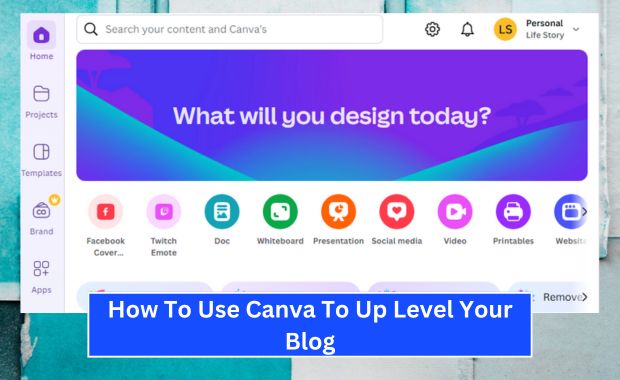In the competitive world of blogging, standing out is more crucial than ever. One of the most effective tools for taking your blog to the next level is Canva—a versatile, user-friendly design platform that empowers users to create stunning visuals without needing advanced graphic design skills. In this guide, we’ll explore how to harness Canva’s features to boost your blog’s appeal, readability, and SEO performance in 2025.

Why Visual Content Matters for Blogs
Visual content is no longer optional in blogging—it’s essential. Here are some statistics that highlight its importance: SEO Analyzer.
| Statistic | Source |
|---|---|
| Articles with images get 94% more views | Social Media Examiner |
| Infographics are 3x more likely to be shared | HubSpot |
| 73% of readers focus on blog images first | Content Marketing Institute |
Compelling visuals improve user engagement, increase time spent on your site, and reduce bounce rates—all of which are critical SEO metrics.
Getting Started with Canva
Step 1: Create a Canva Account
Sign up for a free or Pro account on Canva’s website. While the free version is robust, a Pro account unlocks advanced features like:
- Brand Kit for consistent branding.
- Access to premium templates and stock images.
- Resizing designs for multiple platforms with one click.
Step 2: Familiarize Yourself with the Interface
Explore the dashboard, where you can:
- Search templates by category (e.g., blog banners, infographics).
- Use the drag-and-drop editor to customize designs.
- Save and organize projects in folders.
Essential Canva Features for Bloggers
1. Templates
Canva offers thousands of pre-designed templates tailored for:
- Blog headers
- Social media posts
- Infographics
2. Elements
Use icons, shapes, and illustrations to create dynamic visuals. For instance:
- Highlight key statistics with shapes.
- Use arrows to direct attention to CTAs.
3. Text Tools
Typography plays a significant role in readability. Canva provides:
- Over 1,000 fonts
- Font pairing suggestions
- Text effects like shadows and outlines
4. Photo and Video Library
Access millions of high-quality images and videos to complement your blog content.
5. Brand Kit
Maintain consistency by uploading your logo, choosing brand colors, and saving preferred fonts.
Creating Blog Graphics That Rank and Engage
Infographics
Infographics break down complex information into digestible visuals. Use Canva to: Rank Math vs. Yoast SEO.
- Start with templates designed for data visualization.
- Add charts, graphs, and icons.
- Optimize with keyword-rich alt text.
Social Media Promotions
Promote your blog on platforms like Instagram and Pinterest with visually striking posts.
- Design vertical graphics for Pinterest, which has the highest referral rate for blogs.
- Use Canva’s animation tools to create engaging social stories.
Call-to-Action (CTA) Banners
CTAs drive conversions. Use Canva to design banners that:
- Feature bold, legible text.
- Use contrasting colors to grab attention.
- Incorporate urgency (e.g., “Download Now” or “Limited Time Offer”).
NLP-Optimized Visuals: The Intersection of Design and SEO
Natural Language Processing (NLP) algorithms analyze the content of your visuals as well as text. To ensure your visuals contribute to SEO:
| NLP Optimization Tip | Implementation with Canva |
| Use keyword-rich file names | Rename files in Canva before downloading |
| Add alt text to images | Describe visuals accurately with primary keywords |
| Compress images for fast loading | Export at optimized sizes without losing quality |
By aligning visual content with search intent, you’ll attract and retain more readers.
Step-by-Step Guide: Designing Blog Graphics with Canva
Step 1: Choose a Template
Start with a blog-related template such as a header or infographic. Customize the dimensions to fit your blog’s layout. Rank Math SEO Plugin for WordPress.
Step 2: Add Branding
- Upload your logo and set brand colors.
- Choose consistent fonts from your Brand Kit.
Step 3: Incorporate Visual Elements
- Add icons to represent data.
- Use photos that resonate with your audience.
Step 4: Write Compelling Text
- Keep headlines short and impactful.
- Use subheadings to break up content.
- Add CTAs like “Read More” or “Subscribe Now.”
Step 5: Optimize for Web
- Export images in PNG or JPEG format.
- Compress files for faster page loading.
- Include descriptive file names (e.g., “SEO-tips-infographic.png”).
Tips to Stay Ahead with Canva Trends in 2025
- Leverage AI-Powered Tools Canva’s AI features, such as Magic Resize and text-to-image generation, can save time and enhance creativity.
- Focus on Accessibility Design graphics with inclusive colors and readable fonts to cater to diverse audiences.
- Embrace Minimalism Simplify your designs to align with modern aesthetic trends.
Case Studies: Blogs That Shine with Canva
Case Study 1: The Foodie Chronicles
Challenge: Low engagement on recipe blogs.
Solution:
- Created visually appealing recipe cards using Canva templates.
- Designed Pinterest graphics that increased shares by 150%.
Outcome:
- Page views doubled within three months.
Case Study 2: The Travel Nomad
Challenge: Struggling to convert readers into subscribers.
Solution:
- Designed vibrant CTAs and email opt-in banners.
- Used Canva’s photo editor to enhance travel imagery.
Outcome:
- Subscriber base grew by 40% in six months.
Conclusion
Canva is an indispensable tool for bloggers in 2025, enabling them to create captivating visuals that engage readers and improve SEO. By leveraging Canva’s features and aligning designs with NLP strategies, you can elevate your blog’s impact and reach. Whether you’re a seasoned blogger or just starting, mastering Canva will set you on the path to success.
Start designing today, and watch your blog transform into a visual powerhouse! Yoast SEO Plugin for WordPress.